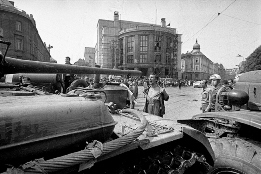 “A young photographer, Ladislav Bielik, did what came naturally. He raised his camera and shot back.”
“A young photographer, Ladislav Bielik, did what came naturally. He raised his camera and shot back.”
Last week, people in Slovakia and Czech republic were commemorating the 45th anniversary of the Soviet invasion of former Czechoslovakia. In August 1968, about 500,000 Soviet troops and most of their Warsaw Pact allies invaded Czechoslovakia, with tanks to halt political liberalization in the country.
Shots were fired also on the Safarikovo Square near where the old bridge crosses the Danube. A 17-year-old girl died. Citizens screamed, cried, fainted. “Socialism with a human face” was over. A young photographer, Ladislav (Laco) Bielik, did what came naturally. He raised his camera and shot back. One of his pictures, “The Bare-chested Man in Front of the Occupiers Tank”, became the shot heard round the world. Within the days, Bielik’s photo splashed across the front page of major newspapers globally. This iconic photo produced indisputable evidence to the iron-fisted response to any challenge of Soviet control [1].
Four decades later, Slovak courts had to decide if a local newspaper – Nový Čas – can use the “Tank Man” picture without permission in their articles when reporting on ’68 events. All the instances said “no”, including the Supreme Court a few months ago.
The Slovak newspaper used “Tank Man” photo repeatedly in 2003 and 2005 without permission and attributing only “foto dse” instead of Mr. Bielik. The “foto dse” attribution most likely meant the German Press Agency (DPA), which was disputing the copyright ownership of the picture before German courts, but lost the case before Regional Court in Frankfurt am Main in 2012.
Heirs of Mr. Bielik’s sued jointly for an infringement of their father’s economic and moral rights to the picture, claiming 4000 EUR as a non-material satisfaction. Newspaper Nový čas, the defendant, disputed even the copyright protection of the “Tank Man”, arguing that the photography constitutes “daily news”, which is excluded from copyright protection. Secondly, the defendant argued that even if the photo is protected as a work of art, newspapers shall be free from using it based on exception for news reporting (Section 35, Article 5(3)(c) of InfoSoc Directive).
Both the first instance (District Court Bratislava II) and the second instance court (Regional Court in Bratislava) rejected all the arguments of the defendant. The photo does, in their opinion, constitute a protected work of art because it “provides a testimony” and its uniqueness comes from “capturing immediate reaction of E.G. [person standing in front of the tank]” and showing his “expression of anger, despair and helplessness”. According to the court, Mr. Bielik recognized the “expressive value” of the moment, which is why the picture is so spellbinding even after all those years. The courts further rejected the applicability of the news reporting exemption, arguing that photos, unlike news per se or public speeches, were not intended as a subject matter covered by this exemption.
Because post-mortal protection of moral rights in Slovakia is potentially perpetual, the heirs of Mr. Bielik had no problem in enforcing the right of attribution and integrity, not even more than 20 years after the death of their father. The second instance court found that not only wrong attribution constituted an infringement upon moral rights, but also the quality changes made to photograph and setting in which their appeared did. The newspaper reproduced the photograph in an unsatisfactory quality, with written addenda and next to a yellow journalism. This in the opinion of the court, did conflict with author’s honor, because Mr. Bielik was also later persecuted in his work because of the “Tank Man” photo.
The Supreme Court approved all the arguments of the lower instance courts.
MH
[1] Quoted with permission from Julia’s wonderful introduction.
A full summary of this case will be added to the Kluwer IP Cases Database ( http://www.kluweriplaw.com).
_____________________________
To make sure you do not miss out on regular updates from the Kluwer Copyright Blog, please subscribe here.
Kluwer IP Law
The 2022 Future Ready Lawyer survey showed that 79% of lawyers think that the importance of legal technology will increase for next year. With Kluwer IP Law you can navigate the increasingly global practice of IP law with specialized, local and cross-border information and tools from every preferred location. Are you, as an IP professional, ready for the future?
Learn how Kluwer IP Law can support you.



Interesting copyright dispute with difficult post-Soviet history in the background…
Very interesting ruling: this photograph is unique and therefore original. The Court of Appeal of Paris ruled, in very much the same way, that “a photograph, in that it results from the instant capture of a particular scene may not be preceded or followed by any other absolutely identical” (Paris, pôle 5, ch. 1, 27 January 2010, no 08/04978). The photographer necessarily made certain choices when he shot the picture (in the first place, he chose the moment). Therefore the photograph contains elements which are the expression of the intellectual creation of the author (ECJ, case C-5/08, Infopaq, para. 39).
Danmarks bedste Beauty Butik Vi har ALT til negle Eyelashes, Voksprodukter og proffessionel hudpleje gele negle